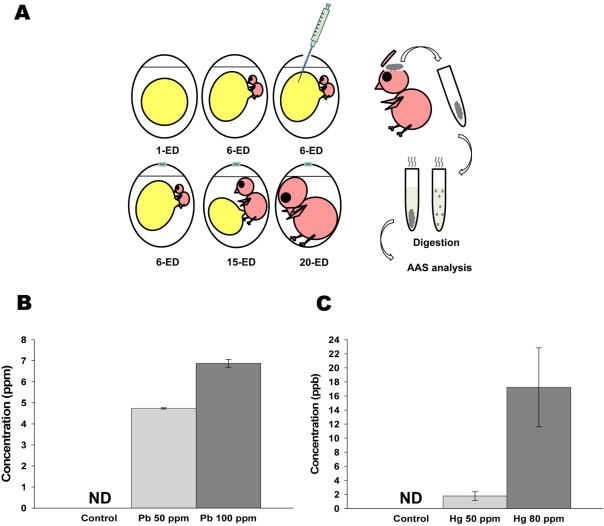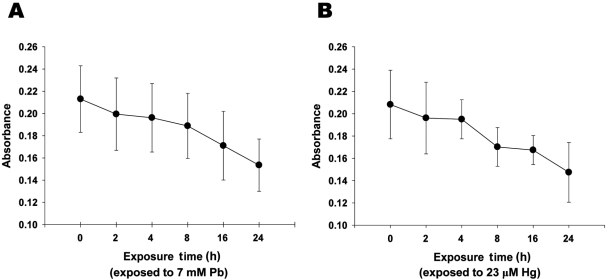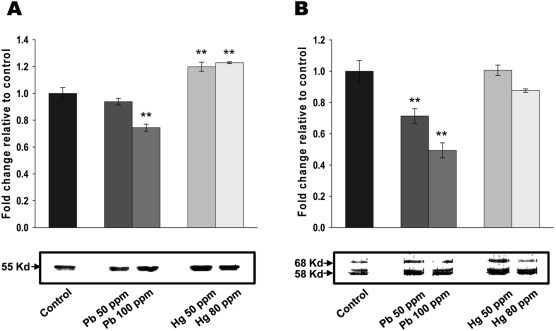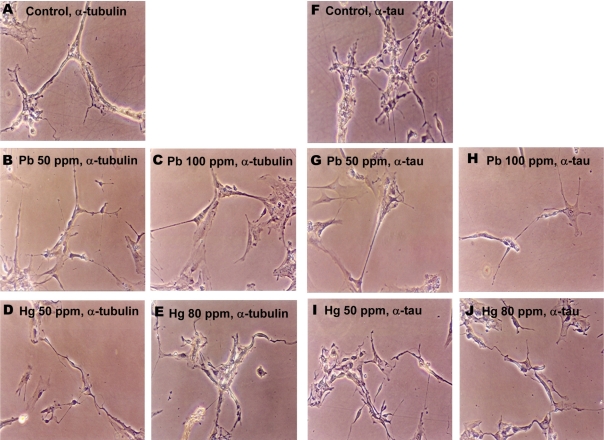Lab Anim Res.
2011 Sep;27(3):219-225. 10.5625/lar.2011.27.3.219.
Inorganic lead (Pb)- and mercury (Hg)-induced neuronal cell death involves cytoskeletal reorganization
- Affiliations
-
- 1College of Veterinary Medicine, Konkuk University, Seoul, Korea. jskim@konkuk.ac.kr
- 2Department of Cellular & Physiological Sciences, Life Sciences Institute, University of British Columbia, Vancouver, Canada.
- KMID: 1850049
- DOI: http://doi.org/10.5625/lar.2011.27.3.219
Abstract
- Inorganic lead and mercury are widely spread xenobiotic neurotoxicants threatening public health. The exposure to inorganic lead and mercury results in adverse effects of poisoning including IQ deficit and peripheral neuropathy. Additionally, inorganic neurotoxicants have even more serious impact on earlier stages of embryonic development. This study was therefore initiated in order to determine the cytotoxic effects of lead and mercury in earlier developmental stages of chick embryo. Administration of inorganic lead and mercury into the chick embryo resulted in the prolonged accumulation of inorganics in the neonatal brain, with detrimental cytotoxicity on neuronal cells. Subsequent studies demonstrated that exposure of chick embryo to inorganic lead and mercury resulted in the reorganization of cytoskeletal proteins in the neonatal brain. These results therefore suggest that inorganics-mediated cytoskeletal reorganization of the structural proteins, resulting in neurocytotoxicity, is one of the underlying mechanisms by which inorganics transfer deleterious effects on central nervous system.
Keyword
MeSH Terms
Figure
Reference
-
1. Manzo L, Castoldi AF, Coccini T, Rossi AD, Nicotera P, Costa LG. Mechanisms of neurotoxicity: applications to human biomonitoring. Toxicol Lett. 1995; 77:63–72. PMID: 7618170.
Article2. Fitsanakis VA, Aschner M. The importance of glutamate, glycine, and gamma-aminobutyric acid transport and regulation in manganese, mercury and lead neurotoxicity. Toxicol Appl Pharmacol. 2005; 204:343–354. PMID: 15845423.3. Taber KH, Hurley RA. Mercury exposure: effects across the lifespan. J Neuropsychiatry Clin Neurosci. 2008; 20:iv-389.
Article4. Baranowska-Bosiacka I, Gutowska I, Marchetti C, Rutkowska M, Marchlewicz M, Kolasa A, Prokopowicz A, Wiernicki I, Piotrowska K, Baskiewicz M, Safranow K, Wiszniewska B, Chlubek D. Altered energy status of primary cerebellar granule neuronal cultures from rats exposed to lead in the pre- and neonatal period. Toxicology. 2011; 280:24–32. PMID: 21108985.
Article5. Reddy GR, Zawia NH. Lead exposure alters Egr-1 DNA-binding in the neonatal rat brain. Int J Dev Neurosci. 2000; 18:791–795. PMID: 11154848.
Article6. Davidson PW, Myers GJ, Weiss B. Mercury exposure and child development outcomes. Pediatrics. 2004; 113:1023–1029. PMID: 15060195.
Article7. Agemian H, Sturtevant DP, Austen KD. Simultaneous acid extraction of six trace metals from fish tissue by hot block digestion and determination by atomic absorption spectrometry. Analyst. 1980; 105:125–130. PMID: 7386893.8. Thier R, Bonacker D, Stoiber T, Böhm KJ, Wang M, Unger E, Bolt HM, Degen G. Interaction of metal salts with cytoskeletal motor protein systems. Toxicol Lett. 2003; 140-141:75–81. PMID: 12676453.
Article9. Albrecht J, Matyja E. Glutamate: a potential mediator of inorganic mercury neurotoxicity. Metab Brain Dis. 1996; 11:175–184. PMID: 8776719.
Article10. Savolainen KM, Loikkanen J, Eerikäinen S, Naarala J. Interactions of excitatory neurotransmitters and xenobiotics in excitotoxicity and oxidative stress: glutamate and lead. Toxicol Lett. 1998; 102-103:363–367. PMID: 10022280.
Article11. Toimela TA, Tähti H. Effects of mercury, methyl mercury and aluminium on glial fibrillary acidic protein expression in rat cerebellar astrocyte cultures. Toxicol In Vitro. 1995; 9:317–325. PMID: 20650093.12. Gorell JM, Johnson CC, Rybicki BA, Peterson EL, Kortsha GX, Brown GG, Richardson RJ. Occupational exposure to manganese, copper, lead, iron, mercury and zinc and the risk of Parkinson's disease. Neurotoxicology. 1999; 20:239–247. PMID: 10385887.13. Counter SA, Buchanan LH. Mercury exposure in children: a review. Toxicol Appl Pharmacol. 2004; 198:209–230. PMID: 15236954.
Article14. Monnet-Tschudi F, Zurich MG, Schilter B, Costa LG, Honegger P. Maturation-dependent effects of chlorpyrifos and parathion and their oxygen analogs on acetylcholinesterase and neuronal and glial markers in aggregating brain cell cultures. Toxicol Appl Pharmacol. 2000; 165:175–183. PMID: 10873710.
Article15. Zurich MG, Eskes C, Honegger P, Bérode M, Monnet-Tschudi F. Maturation-dependent neurotoxicity of lead acetate in vitro: implication of glial reactions. J Neurosci Res. 2002; 70:108–116. PMID: 12237869.16. Morken TS, Sonnewald U, Aschner M, Syversen T. Effects of methyl mercury on primary brain cells in mono- and co-culture. Toxicol Sci. 2005; 87:169–175. PMID: 15958655.17. Richards MP, Packard MJ. Mineral metabolism in avian embryos. Poult Avian Biol Rev. 1996; 7:143–161.18. Kerper LE, Hinkle PM. Lead uptake in brain capillary endothelial cells: activation by calcium store depletion. Toxicol Appl Pharmacol. 1997; 146:127–133. PMID: 9299604.
Article19. Legare ME, Barhoumi R, Hebert E, Bratton GR, Burghardt RC, Tiffany-Castiglioni E. Analysis of Pb2+ entry into cultured astroglia. Toxicol Sci. 1998; 46:90–100. PMID: 9928672.20. Dyatlov VA, Platoshin AV, Lawrence DA, Carpenter DO. Lead potentiates cytokine- and glutamate-mediated increases in permeability of the blood-brain barrier. Neurotoxicology. 1998; 19:283–291. PMID: 9553965.21. Silbergeld EK. Mechanisms of lead neurotoxicity, or looking beyond the lamppost. FASEB J. 1992; 6:3201–3206. PMID: 1397842.
Article22. Bressler J, Kim KA, Chakraborti T, Goldstein G. Molecular mechanisms of lead neurotoxicity. Neurochem Res. 1999; 24:595–600. PMID: 10227691.23. Rossi AD, Larsson O, Manzo L, Orrenius S, Vahter M, Berggren PO, Nicotera P. Modifications of Ca2+ signaling by inorganic mercury in PC12 cells. FASEB J. 1993; 7:1507–1514. PMID: 8262335.24. Miura K, Himeno S, Koide N, Imura N. Effects of methyl mercury and inorganic mercury on the growth of nerve fibers in cultured chick dorsal root ganglia. Tohoku J Exp Med. 2000; 192:195–210. PMID: 11249149.25. Taniguchi T, Kawamata T, Mukai H, Hasegawa H, Isagawa T, Yasuda M, Hashimoto T, Terashima A, Nakai M, Mori H, Ono Y, Tanaka C. Phosphorylation of tau is regulated by PKN. J Biol Chem. 2001; 276:10025–10031. PMID: 11104762.
Article26. Tseng HC, Lu Q, Henderson E, Graves DJ. Phosphorylated tau can promote tubulin assembly. Proc Natl Acad Sci USA. 1999; 96:9503–9508. PMID: 10449722.
Article27. Zimmermann HP, Faulstich H, Hansch GM, Doenges KH, Stournaras C. The interaction of triethyl lead with tubulin and microtubules. Mutat Res. 1988; 201:293–302. PMID: 3173379.
Article28. Roderer G, Doenges KH. Influence of trimethyl lead and inorganic lead on the in vitro assembly of microtubules from mammalian brain. Neurotoxicology. 1983; 4:171–180. PMID: 6685258.29. Leong CC, Syed NI, Lorscheider FL. Retrograde degeneration of neurite membrane structural integrity of nerve growth cones following in vitro exposure to mercury. Neuroreport. 2001; 12:733–737. PMID: 11277574.
- Full Text Links
- Actions
-
Cited
- CITED
-
- Close
- Share
- Similar articles
-
- Lead acetate- induced neurodegenerative changes in the dorsolateral prefrontal cortex of mice: the role of Vitexin
- Human Exposure and Health Effects of Inorganic and Elemental Mercury
- Environmental Heavy Metal Exposure and Chronic Kidney Disease in the General Population
- Overexpression of Ref-1 Inhibits Lead-induced Endothelial Cell Death via the Upregulation of Catalase
- Apoptosis of Neuronal Cells Induced by Lead





